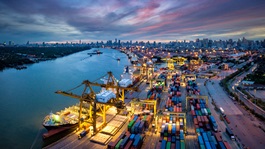Analysing Article 6 Readiness in APAC
As mentioned above, the APAC region was a dominant force in carbon markets even prior to the operationalisation of the Article 6 Rulebook. Nonetheless, to leverage the new opportunities which Article 6.2 and PACM will create, APAC countries are increasingly adopting or refining their carbon infrastructure and technical capacity to enable the generation, authorisation and transfer of Article 6 units. In this section, we consider eight key players and the steps they are taking to develop their carbon market readiness.
Cambodia

Cambodia has engaged in the voluntary carbon market since at least 2016 and is host to several large ‘reducing emissions from deforestation and forest degradation’ (known as “REDD+”) projects. Prior to COP29, it had demonstrated its interest in the Article 6 mechanisms by providing letters of authorisation to two Verra projects in early 2024.
In 2024, Cambodia published its “Operations Manual for the Implementation of Article 6 of the Paris Agreement on Climate Change in Cambodia” (Manual). The Manual demonstrates Cambodia’s willingness to be seen as a suitable location to host a project, by outlining (via step-by-step flowcharts) how proponents can obtain authorisation and implement their projects. The Manual also provides templates of relevant forms in its annexures.
The Manual set out the following eligibility criteria for projects to receive authorisation:
- The project must be included in the “positive list” of projects – this is the list of “conditional” activities in Cambodia’s most recent NDC.
- A share of the Article 6 units must be reserved for domestic use – this is to ensure that at least some units from each project will be used towards meeting Cambodia’s NDC targets.
- Authorised units must be issued by an eligible carbon mechanism – this means the authorised units are issued under one of the following: (i) Article 6.2 Cooperative Approaches; (ii) PACM; or (iii) “independent carbon mechanisms” (such as Verra and Gold Standard).
- The Article 6 units must be “real, verified, and additional” – the Manual provides requirements to be met, such as that Article 6 units have been independently verified.
- The Article 6 units must have been generated in 2021 or later.
- The project must ensure “environmental integrity” – the requirements for this include setting conservative baselines and minimising the risk of non-permanence.
- The project must be aligned with Cambodia’s sustainable development priorities – these include poverty alleviation and improved public health (see Table 2 in the Manual).
The Manual confirms that ownership of the Article 6 units shall be conferred to authorised project proponents at the point of issuance. It also recognises that the Government may claim 10 per cent of Article 6 units where it is “explicitly stated” that the Government of Cambodia took the lead in enacting “policies or legal frameworks necessary for the successful generation of [Article 6 units] by the project.
As to its carbon market infrastructure, Cambodia intends to use the UN-operated PACM registry and other existing registries, including those managed by the “independent crediting mechanisms”, whilst it develops its own national registry.
In its third NDC (published in August 2025), Cambodia reconfirmed its commitment to hosting Article 6 projects by highlighting areas in which it is looking to leverage “Article 6 financing mechanisms”. These include projects focused on transitioning to sustainable firewood and feedstock and reducing deforestation (through REDD+ projects).
India

India has substantial experience with carbon markets as it is the country with the second highest number of CDM projects globally. More recently, the development of carbon market infrastructure in India has been focused on establishing its “Carbon Credit Trading Scheme” (CCTS) under which carbon projects can generate “carbon credits certificates” (CCCs). The CCTS complements a new ‘compliance mechanism’ whereby “obligated entities” in nine sectors must meet prescribed emissions intensity targets. If an “obligated entity” overachieves its target, it can earn CCCs which can be sold via the CCTS. If it fails to meet its target, it must purchase and surrender CCCs.
The administrator of the CCTS and the issuer of CCCs is the Bureau of Energy Efficiency. The operator of the CCTS registry is the Grid Controller of India. In March 2025, India announced eight methodologies for the CCTS relating to, amongst other things, industrial energy efficiency, landfill methane recovery, and mangrove afforestation and reforestation. Further information on the CCTS can be found in the document “Detailed Procedure for Offset Mechanism under CCTS”.
The implementation of the CCTS will undoubtedly refine India’s carbon market infrastructure and expertise, both of which will make it a suitable location for developing projects under the Article 6 mechanisms.
India has historically demonstrated interest in Article 6 opportunities. In June 2024, it released an updated list of Article 6.2 activities and an identical list of PACM activities, which will be “considered for trading of carbon credits”. The lists include solar power generation, clean cooking, sustainable aviation fuel, an “alternative materials” activity and a carbon capture, utilisation and storage activity. In August 2025, India also signed its first Article 6.2 MOU (MOU) with Japan (which will also fall under Japan’s expansive Joint Crediting Mechanism). Furthermore, it was recently announced that India’s carbon market portal is expected to be interoperable with Article 6.2 by December 2025, enabling proponents to register their CCTS projects under Article 6.2.
Indonesia

Indonesia’s geography makes it well-suited to hosting nature-based solutions and it has been identified as a possible future “natural supply powerhouse”. It is estimated that by 2030, it could be generating up to 1,283 million tonnes of carbon credits annually. The Indonesian Government seems to be acutely aware of this potential. Over the past few years, it has implemented a series of carbon market regulations to ensure the country’s readiness for carbon project opportunities.
Firstly, Presidential Regulation No.98 of 2021 provided the foundation of a carbon pricing scheme called the “Economic Value of Carbon” or “Nilai Ekonomi Karbon” (NEK) which was launched in 2023. Similar to compliance schemes in Australia and India, the NEK applies emissions-intensity targets to facilities in the power sector (initially only coal power stations with a capacity above 25 MW). The NEK will capture oil and gas power plants from 2027, as well as the metal, fertiliser and chemicals sectors. The NEK was bolstered by legislation which, in 2022, established Indonesia’s Carbon Trading Roadmap and rules for the issuance of “Emissions Reduction Certificates” or “Sertifikat Pengurangan Emisi” (SPE-GRK), and in 2023, outlined the rules for trading SPE-GRKs on Indonesia’s carbon exchange (known as “IDX Carbon”).
In turn, Indonesia has successfully negotiated several Article 6 agreements. In June 2025, Norway and Indonesia signed an implementation agreement under Article 6.2. (Norway and Indonesia had previously agreed a 2022 MOU confirming collaboration on Indonesia’s “Forestry and Other Land Use Net Sink 2030” plan.) Indonesia has also signed Article 6.2 MOUs with Singapore, South Korea and Japan.
In January 2025, Indonesia launched an initiative with IDX Carbon focused on international carbon trading, however this has been slightly dampened owing to integrity concerns about some credits from Indonesian projects. To address this, Indonesia signed Mutual Recognition Agreements (MRAs) with Gold Standard in May 2025, and Verra in October 2025. As a result, Indonesian projects can now be recorded in both the Indonesian National Registry System for Climate Change Control and the Gold Standard or Verra registries. This enables these projects to benefit from a streamlined project registration process, improved monitoring, reporting and validation processes, and support when trading credits internationally.
In October 2024, Japan formalised a MRA with Indonesia that recognises the equivalence of JCM credits and SPE-GRKs. While Indonesia already hosts 51 JCM projects, the MRA will streamline future carbon trading between the two countries. This may result in greater demand for projects generating Article 6 units in Indonesia over the coming years.
As Indonesia looks to define itself as an optimal location for hosting Article 6 projects, it will be aided by the development of its internal market over the previous few years and a clear focus in 2025 on boosting the integrity of its projects. This means it should be well-placed to deliver on its Article 6.2 agreements and seize on additional opportunities in the future.
Japan

Japan is one of the most experienced and proactive countries engaging in cooperative emissions reduction having established its own model of cooperative approaches, the Joint Crediting Mechanism (JCM), in 2013. The JCM is implemented via bilateral agreements under which Japan subsidises and contributes technology to decarbonisation projects in the partner country, with these projects producing credits which are shared between the two countries. Japan is now party to 31 JCM country agreements, with the first being agreed with Mongolia in 2013 and the most recent one being signed with India in August 2025. Japan aligned the JCM with the Article 6 Rulebook prior to the Rulebook’s adoption at COP29.
Japan relies heavily on carbon credits to meet its reduction targets and is expected to grow the JCM substantially in the coming years through new projects and partnerships. According to its NDC, Japan intends to use JCM projects to secure approximately 100 million tCO2-e in emission reductions and removals by 2030 and approximately 200 million tCO2-e by 2040. Additionally, in May 2025, Japan made its national emissions trading scheme (ETS) mandatory for companies which emit more than 100,000 tCO2-e per year (from the 2026 financial year onwards). This is expected to capture 300-400 entities. As JCM credits can be surrendered for compliance purposes, Japan’s national ETS is therefore likely to be a key driver of the continued expansion of the JCM.
Japan is the secretariat of the Article 6 Implementation Partnership, which contributes to capacity building and knowledge-sharing among countries that implement Article 6. Considering Japan’s extensive experience in cooperative emissions reduction and its many existing JCM agreements, it is unsurprising that Japan is shaping best practices for countries which are only just beginning to engage with the Article 6 mechanisms.
Malaysia

Article 6 readiness is a prime focus in Malaysia. In early October 2025, Malaysia’s Deputy Natural Resources and Environmental Sustainability Minister spoke at the Dewan Rakyat (Malaysia’s Parliament) to confirm that the government is finalising the National Carbon Market Policy. The policy will outline how Malaysia will implement both Article 6 mechanisms and expand the voluntary carbon market under the Bursa Carbon Exchange (which is the Malaysian exchange for the trading of carbon credits and renewable energy certificates).
He also said that Malaysia is developing technical infrastructure to comply with Article 6.4, including a regulatory body and registry to record transactions. In relation to Article 6.2, Malaysia signed MOUs with Korea in November 2024 and with Singapore in January 2025 (with the intention being to finalise an implementation agreement with Singapore by the end of 2025).
Beyond the Article 6 mechanisms, Malaysia has been developing its broader carbon markets infrastructure over the past few years with a specific focus on carbon abatement opportunities arising in the forestry sector and from carbon capture and storage. In July 2024, the Bursa Carbon Exchange carried out its first auction of Malaysian carbon credits. These were sourced from the Kuarmut Rainforest Conservation Project, which is registered under Verra and has received international attention for its size, covering 84,000 hectares of forest.
With its significant carbon abatement potential and a clear willingness to engage with Article 6, Malaysia looks set to be an ideal location for hosting Article 6 projects.
Singapore

Singapore has emerged as a major player in carbon markets, defining itself as a “carbon services and trading hub”.
Whilst it has limited natural resources to generate carbon credits, Singapore has enthusiastically embraced the Article 6 mechanisms to progress its NDC targets. It agreed its first Cooperative Approach with Papua New Guinea in 2023 and has now signed more Article 6.2 bilateral agreements than any other Party to the Paris Agreement, except Japan. Further, Singapore has fostered demand for Article 6 units by recognising them as eligible under its International Carbon Credit (ICC) Framework, which permits carbon taxable facilities to use eligible ICCs to offset up to 5 per cent of their taxable emissions. The ICC Framework requires ICCs to be produced under specific Verra or Gold Standard methods, and to satisfy the framework’s high-integrity principles.
To ensure that ICCs issued are adequately validated, verified, issued and retired, Singapore’s National Environmental Agency signed MOUs with five carbon credit programs to utilise their advanced capabilities and resources. These include the Gold Standard, Verra, Global Carbon Council, American Carbon Registry and the Architecture for REDD+ Transactions.
Singapore has also established itself as a global carbon trading hub by leveraging its reputation for financial services and commodity trading. There are now 70 different organisations providing carbon-related services in Singapore, including Climate Impact X. This has been partially a result of Singapore’s “Emerging Strong Taskforce: Alliances for Action”, which develops public-private partnerships to address tricky challenges, one of these being the development of a trustworthy and robust voluntary carbon market.
Finally, Singapore has been involved in providing recommendations and uniform approaches toward Article 6. At COP28, Singapore, Gold Standard and Verra announced they were developing an Article 6 Playbook to provide a harmonised standard of operating procedures for countries to increase their use of existing independent carbon crediting programs (ICPs). In November 2024, this group released the initial recommendations for an Article 6.2 Crediting Protocol (Protocol). The Protocol emphasised the benefits of using ICPs in Article 6 cooperation and set out a timeline for development of the Article 6 Playbook. Moreover, in June 2025, Singapore announced the “Coalition to Grow Carbon Markets” with the United Kingdom and Kenya, which promotes private sector demand for carbon credits and continued progress on Article 6.
Thailand

Thailand has also taken a leading role within APAC to maximise Article 6 opportunities. In January 2024, Thailand and Switzerland were the first countries to successfully implement an authorised mitigation activity under Article 6.2 and transfer Article 6 units. Thailand has signed various JCM agreements and has 11 registered JCM projects. International agreements and Article 6 unit transfers can be tracked through the Thailand Carbon Credit Registry (TCCR), managed by the Greenhouse Gas Management Organisation (TGO), which records carbon credit projects in Thailand and total credit issuance.
Thailand’s ability to engage with Article 6 has been bolstered by the development of its domestic voluntary emission reduction program (T-VER). T-VER was launched in 2013 and enables proponents to carry out greenhouse gas abatement projects in the energy efficiency, waste management, transport, forestry and agricultural sectors. This not only meant that the TCCR was already in place when the Article 6 Rulebook was finalised, but also that Thailand could quickly produce policies and guidelines for the creation and transfer of Article 6 units.
Whilst the TGO supports Article 6 project registration, monitoring and verification, the National Committee on Climate Change Policy (NCCC) is responsible for overseeing the implementation of Article 6 policies. In September 2025, the Thai Cabinet adopted the “International Carbon Credit Guideline” (Guideline) to align Thailand’s domestic carbon credit framework with the Article 6 mechanisms, including establishing the Department of Climate Change and Environment as the Designated National Authority (which is responsible for issuing letters of authorisation) and confirming that the TGO will manage record transfers of Article 6 units and coordinate with the UN’s Article 6.4 Supervisory Body. The Guideline also identified ten project types – covering the energy, forestry, agriculture, transport, waste management and carbon capture and storage sectors – which can generate carbon credits to be transferred overseas.
Thailand has also been making efforts to elevate integrity within T-VER, especially following the failure of T-VER credits to satisfy some international standards, as demonstrated by these credits recently being deemed ineligible for use under CORSIA. In August 2022, Verra and the TGO signed a MOU to ensure T-VER standards align with international best practice. In 2023, the TGO released more stringent ‘Premium T-VER’ rules, which continue to be revised to ensure consistency with international standards.
This has likely contributed to a strong growth in carbon credit trading in Thailand, and a correlative increase in the value of T-VER credits. From October to December 2024, T-VER reached a record high in carbon credits traded, amounting to $834,000 AUD. The Thai Government is supporting the momentum with a proposed measure to allow businesses to use carbon credits to offset 15 per cent of their carbon tax liabilities. Once in place, the carbon tax would cover Thailand’s transport, energy and industrial sectors which account for about 30 per cent of Thailand’s emissions.
Viet Nam

Although Article 6 was not mentioned in Viet Nam’s latest NDC, it has historically shown interest in engaging with other countries to cooperate on climate change. In 2013, Viet Nam signed a bilateral agreement with Japan, making it the sixth country to join the JCM. In total, Viet Nam has 48 JCM projects of which 9 have successfully been issued with credits. Separately, Viet Nam has signed Article 6.2 bilateral agreements with South Korea and Singapore, with the latter being agreed in September 2025.
Most carbon credit projects within Viet Nam take place under voluntary schemes, with 44 projects registered under Verra and 42 under the Gold Standard as of October 2025. Viet Nam holds significant potential in generating carbon credits through mangrove forest restoration, renewable energy development and waste management, however its domestic carbon infrastructure is considered fragmented and limited.
Currently Viet Nam does not have a formalised national carbon credit trading system to rely on as support for Article 6 implementation. However, it is in the process of implementing an emissions trading system which will operate on a hybrid basis of government-allocated emissions allowances and an obligation for captured entities to purchase and surrender carbon credits if their emissions surpass those allowances. The first phase of the scheme, which launched in June 2025, targets steel, cement and thermal power producers. Credits which are eligible to be used for compliance purposes can be sourced from domestic and international mechanisms including PACM, the JCM and the CDM.
It is anticipated that the implementation of Viet Nam’s emissions trading scheme will create demand for domestic projects and the purchase of Article 6 units from overseas. It will also entail the development of critical carbon markets infrastructure to enable Viet Nam to access additional Article 6 opportunities in the future.


















